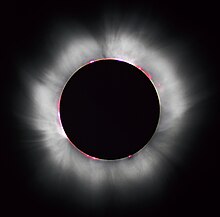Corona
A corona is an aura of plasma which surrounds the sun and other stars.[1] The Sun's corona extends millions of kilometres into space and is most easily seen during a total solar eclipse. It is also observable with a device called a coronagraph. The word "corona" is a Latin word meaning "crown", from the Ancient Greek κορώνη (korōnē, “garland, wreath”).

The Sun's corona is much hotter (by a factor from 150 to 450) than the visible surface of the Sun. The photosphere's average temperature is 5800 kelvin compared to the corona's one to three million kelvin.[2] The corona is 10−12 times as dense as the photosphere, and so produces about one-millionth as much visible light. The corona is separated from the photosphere by the relatively shallow chromosphere. The exact mechanism by which the corona is heated is still the subject of some debate. The outer edges of the Sun's corona are constantly being blown away by the open magnetic flux generating the solar wind.
References
change